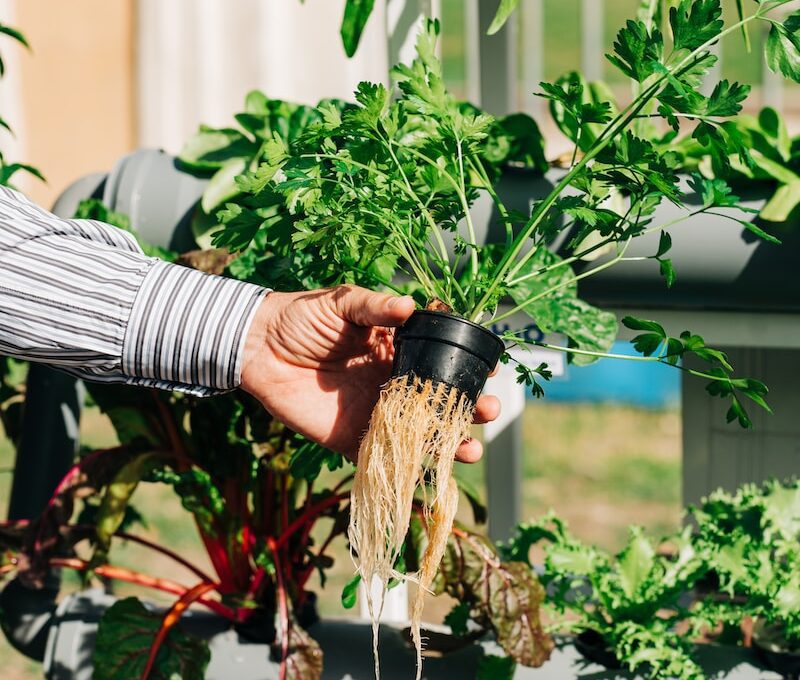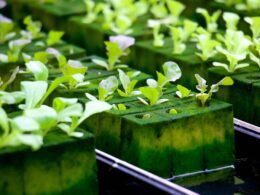Do you love the idea of growing your own plants, but dread the thought of maintaining a traditional garden? Hydroponics may be the answer to your gardening woes. This soil-free method of growing plants has become increasingly popular in recent years due to its efficiency and the ability to grow a wide variety of plants.
But, is hydroponics low maintenance? Let’s take a closer look at the maintenance requirements of hydroponic systems and how you can make it work for you with ease.
While hydroponics may seem intimidating at first, it can actually be a low maintenance way to grow plants once you have everything set up. However, like any gardening method, hydroponics does require some regular attention to ensure your plants are thriving.
In this article, we will explore the maintenance requirements of hydroponics systems, how to prevent and address common issues, and share tips for simplifying hydroponics maintenance. So, whether you’re a seasoned gardener or a beginner, you can learn how to make hydroponics work for you with minimal effort.
Understanding Hydroponics Maintenance Requirements
You’ll find that keeping up with the care and upkeep of your hydroponic system is crucial to ensuring the healthy growth and production of your plants. Maintaining a hydroponics setup requires minimal effort compared to traditional soil gardening. However, there are cost considerations to keep in mind when it comes to setting up and maintaining your hydroponic system.
While hydroponics can be more expensive to set up initially, it can be more cost-effective in the long run due to increased yield potential and reduced water usage. When it comes to hydroponic crop selection, you have a wide variety of options. The yield potential of hydroponic crops is much higher than traditional soil farming. Additionally, the controlled environment of a hydroponic system allows for year-round growing and increased crop yields.
However, it’s important to understand that different crops have different maintenance requirements. Some crops may require more attention and care than others, which can impact the overall maintenance requirements of your hydroponic system. In conclusion, hydroponics can provide a low-maintenance solution for those looking to grow their own crops.
While there are initial costs associated with setting up a hydroponic system, the potential for increased yield and reduced water usage can make it a cost-effective option in the long run. Keep in mind that different crops have different maintenance requirements, so it’s important to choose the right crops for your hydroponic system. With proper care and attention, you can enjoy healthy growth and production from your hydroponic plants.
Regular Monitoring and Adjustment
You need to regularly monitor and adjust pH and nutrient levels, water quality, lighting, and temperature control to maintain a thriving hydroponic system. Keeping the pH levels in the optimal range is crucial for nutrient uptake and plant growth.
Consistently checking water quality and adjusting nutrient levels will help prevent nutrient deficiencies and toxicity. Proper lighting and temperature control will ensure that plants are receiving the right amount of light and warmth for healthy growth.
pH and Nutrient Levels
It’s important to regularly monitor and adjust the pH and nutrient levels in your hydroponic system to ensure healthy plant growth and maximum yield.
pH stability is crucial because fluctuations can negatively impact plant growth and lead to nutrient deficiencies or toxicities. Ideally, the pH level in your system should remain between 5.5 and 6.5. Regular testing and adjustment using pH up or pH down solutions will help maintain this stability.
Nutrient balance is equally important in hydroponics. Plants require a specific balance of nutrients, including nitrogen, phosphorus, and potassium, as well as micronutrients like calcium and magnesium. Monitoring nutrient levels and adjusting them as necessary is key to optimal plant growth and health.
A nutrient solution that is too weak can result in stunted growth, while one that is too strong can lead to nutrient burn. Regular monitoring and adjustment of nutrient levels will help ensure that your plants are getting the right balance of nutrients for maximum yield.
Water Quality
Ensuring the quality of your water is essential for healthy plant growth in a hydroponic system. Using tap water can contain harmful chemicals and minerals that could damage your plants. So, it’s important to invest in a water filtration system. This will protect your plants, promote better nutrient absorption, and increase your yield.
In addition to water filtration, using appropriate nutrient solutions is crucial for maintaining plant health. Regularly check and adjust nutrient levels to ensure your plants receive the correct balance of minerals for optimal growth. By taking care of your water quality and nutrient solutions, you can reduce the maintenance required in your hydroponic system and enjoy a thriving garden with minimal effort.
Lighting and Temperature Control
Maintaining the perfect balance of light and temperature in your hydroponic setup is key to achieving a bountiful harvest and feeling proud of your green thumb. Here are some tips to help you control these variables:
-
LED vs fluorescent lighting: LED lights are more energy-efficient and produce less heat than fluorescent lights, which can help you save on electricity costs and prevent overheating in your grow space. They also have a longer lifespan, so you won’t have to replace them as often.
-
Optimal temperature range: The ideal temperature range for most hydroponic plants is between 65 and 80 degrees Fahrenheit. You can use a thermometer to monitor the temperature in your grow space and adjust it as needed using fans, heaters, or air conditioning units.
-
Light duration: Most plants require at least 12 hours of light per day, but some may need up to 18 hours. Make sure to set a timer to ensure your plants are getting the right amount of light each day.
-
Light distance: The distance between your plants and the light source can also affect their growth. Generally, LED lights can be placed closer to your plants than fluorescent lights, which can help you save space in your grow room.
By following these guidelines, you can ensure that your hydroponic setup is low maintenance and your plants are thriving. With the right lighting and temperature control, you’ll be able to enjoy a successful harvest and feel confident in your hydroponic skills.
Preventing and Addressing Common Issues
Dealing with common problems in your hydroponics setup doesn’t have to be a headache, and there are ways to prevent them from happening in the first place. One of the most important things you can do is to practice good pest management. This means regularly checking your plants for signs of infestation and taking action as soon as possible. You can also use natural methods like introducing beneficial insects or using organic pesticides to keep pests at bay.
Another important aspect of low maintenance hydroponics is equipment maintenance. Regularly cleaning and sanitizing your equipment can help prevent issues like algae buildup or clogged tubing. It’s also a good idea to keep spare parts on hand in case of a malfunction or breakdown. By taking these steps, you can keep your hydroponic system running smoothly and avoid costly repairs down the line.
To summarize, while hydroponics can be a low maintenance method of growing plants, it’s important to stay on top of common issues. By practicing good pest management and equipment maintenance, you can prevent problems from occurring and keep your system running smoothly. With a little bit of effort and attention, you can enjoy the benefits of hydroponics without the stress of dealing with constant problems.
| Common Issues | Prevention Tips |
|---|---|
| Pest Infestations | Regularly check plants for signs of infestation and take action immediately. Use natural methods like introducing beneficial insects or organic pesticides. |
| Equipment Malfunctions | Regularly clean and sanitize equipment. Keep spare parts on hand in case of a breakdown. |
| Algae Buildup | Use a UV sterilizer or algaecide to prevent algae from growing. Regularly clean and sanitize equipment. |
Choosing the Right Hydroponic System
Now you can easily pick the perfect hydroponic system that suits your needs and start growing your own fresh, healthy produce at home! When choosing a system, consider the space available, the type of plants you want to grow, and your budget.
Here are some options to help you get started:
-
Vertical farming systems are perfect for small spaces. They use gravity to deliver nutrient solution to the plants, and they can be stacked to maximize space. Plus, they’re easy to maintain and harvest.
-
If you have more space available, consider a nutrient film technique (NFT) system. This type of hydroponic system uses a continuous flow of nutrient solution to deliver nutrients to the plants. It’s a great option for leafy greens and herbs.
-
For larger plants like tomatoes or cucumbers, a deep water culture (DWC) system may be the best choice. In a DWC system, the roots of the plants are submerged in nutrient solution, and an air stone provides oxygen to the roots. This system is relatively low maintenance and can produce high yields.
No matter which system you choose, make sure to monitor the pH and nutrient levels regularly and adjust as needed. With the right hydroponic system, you can enjoy fresh, healthy produce all year round without the hassle of traditional gardening. So, get started today and see the benefits of hydroponic gardening for yourself!
Tips for Simplifying Hydroponics Maintenance
To simplify the upkeep of your hydroponic system, you may want to consider implementing these tips in order to streamline your gardening process and ensure optimal plant growth.
First and foremost, hydroponic automation can greatly reduce the amount of time and effort you spend on maintenance. Automated systems can control everything from nutrient delivery to lighting schedules, allowing you to focus on other aspects of your garden.
Another tip is to choose efficient systems that require less maintenance. For example, aeroponic systems use less water and require less cleaning than other types of hydroponic systems. Additionally, choosing high-quality components can reduce the likelihood of malfunctions and minimize the need for repairs.
Lastly, regular maintenance is key to avoiding larger problems down the line. Schedule routine checks of your system’s pH levels, nutrient levels, and overall health of your plants. Catching small issues early on can prevent larger problems and save you time and money in the long run.
By following these tips, you can simplify the maintenance of your hydroponic system and enjoy a thriving garden with minimal effort.
Frequently Asked Questions
What are the most common pests and diseases that can affect hydroponic plants?
To keep your hydroponic plants healthy, it’s important to be aware of common pests and diseases that can affect them. Prevention methods are key, such as maintaining a clean growing environment and regularly checking plants for signs of infestation.
If pests or diseases do occur, treatment options for hydroponic pests and diseases include natural remedies like neem oil or insecticidal soap, as well as more traditional methods like chemical pesticides. Additionally, it’s important to be mindful of nutrient deficiencies in hydroponic plants, which can lead to weakened immune systems and increased susceptibility to pests and diseases.
With proper care and attention, you can keep your hydroponic plants thriving and free from pests and diseases.
Are there any special considerations for maintaining hydroponic systems in extreme temperatures?
If you live in an area with extreme temperatures, there are a few things you should keep in mind when maintaining your hydroponic system. One of the most important considerations is insulation. By using insulation techniques, you can keep your system protected from both extreme heat and cold.
It’s also important to ensure that your water circulation is working properly. This will help to maintain a consistent temperature throughout your system, preventing any fluctuations that could damage your plants.
With these considerations in mind, you can keep your hydroponic system thriving, even in extreme temperatures.
How do you prevent algae growth in hydroponic systems?
Preventing algae growth is an essential part of hydroponic maintenance. To keep your system clean, start by sterilizing everything before use. Use a UV sterilizer or hydrogen peroxide to kill any potential algae spores.
Ensure that your water is properly oxygenated and well-circulated, as stagnant water can encourage algae growth. Regularly check and adjust the pH and nutrient levels of your system, as imbalances can create an environment that promotes algae growth.
Lastly, keep your hydroponic system out of direct sunlight, as algae thrives in light. By following these simple steps, you can prevent algae growth and maintain a healthy hydroponic system.
What kind of lighting is best for hydroponic plants, and how often should it be replaced?
When it comes to hydroponic plant growth, the right lighting is crucial. LED lighting has proven to be the best choice for hydroponic systems due to its low heat emissions and high efficiency. CFL lighting is also an option, but it tends to produce more heat and consume more energy.
To optimize light spectrum for hydroponic plant growth, you should aim for a balance of red and blue wavelengths. The bulbs should be replaced every 12-18 months, as they lose intensity over time and may negatively affect plant growth.
By choosing the right lighting and replacing bulbs regularly, you can ensure your hydroponic plants receive the light they need to thrive.
Can hydroponic systems be left unattended for extended periods of time, or do they require constant attention?
When it comes to hydroponic systems, long term viability is definitely possible. With the right automation options, you can leave your hydroponic system unattended for extended periods of time without worrying about constant attention.
This is especially true for systems that are equipped with automatic nutrient dosing, pH control, and temperature regulation. While hydroponic systems do require maintenance, they can be low maintenance with the right setup.
So, if you’re looking for a way to grow plants without having to worry about constant upkeep, hydroponics might just be the perfect solution for you.
Conclusion
So, is hydroponics low maintenance? The answer is both yes and no.
While hydroponics does require some regular monitoring and adjustment, it can also be simplified with the right system and approach. To minimize maintenance, it’s important to choose a hydroponic system that fits your needs and abilities. For example, a passive system like a wick or deep water culture may require less maintenance than an active system like an ebb and flow or drip system.
Additionally, taking preventive measures and addressing common issues when they arise can also help minimize maintenance needs. Overall, while hydroponics does require some effort and attention, it can also be a highly rewarding and low-maintenance way to grow plants.
By understanding the maintenance requirements, choosing the right system, and taking proactive measures, you can enjoy the benefits of hydroponics with minimal hassle.








